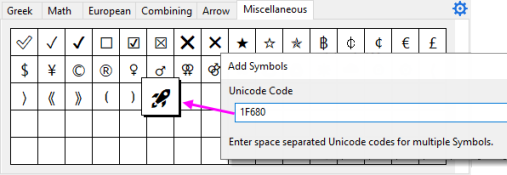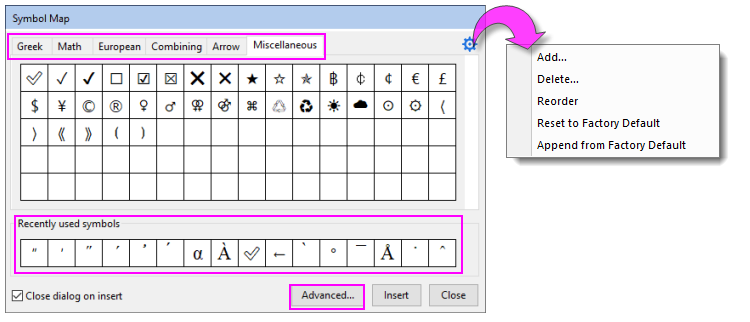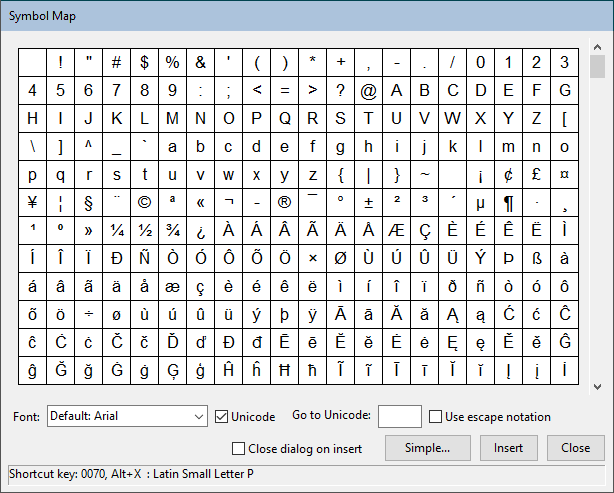2.1.13 Symbol Map and Character MapSymbol-Character-Map
The Symbol Map is used throughout the Origin interface to add special symbols to text objects or to worksheet cells. Thus, these special symbols can be inserted into graphs, worksheets, Layout pages and Notes windows.
Beginning with Origin 2022b, users will find a new, Simple dialog for inserting characters -- with a button that opens the long-time Advanced dialog, when needed.

Related Topics:
Simple Symbol Map
Starting with Origin 2022b, selecting Symbol Map -- while editing a Rich Text enabled worksheet cell, a cell note or Notes window, or a text label on a graph or layout page -- opens a simplified Symbol Map dialog (aka Simple Symbol Map). This change was made to give users quick, point-and-click access to most-used symbols.
In addition, the user can quickly add symbols (beginning with Origin 2023, this includes UTF-32 symbols not supported by the Advanced dialog). All you need are the corresponding code points to add a one or more symbols to the map (but see Changing fonts below).

- Insert symbols from the Greek, Math. European, Combining, Arrow and Miscellaneous tabs.
- The Combining tab is used to insert elements that are often combined with letters in scientific expressions (e.g. adding overline ( ¯ ) to "x").
- Symbols entered from any tab of this dialog -- or from the Advanced dialog -- will be added to the Recently used symbols list.
- If the user is not able to access the desired symbol from this dialog, you can (a) you can use the dialog's Add button to add the symbol (next bullet), (b) click the Advanced button and go to the advanced Symbol Map, or (c) the ALT+X method to enter the symbol directly into your worksheet cell, text label, etc.
- Click the "gear" icon to Add or Delete symbols from the active tab; Reorder symbols in the active tab by dragging; or Reset to "as installed" or Append previously-deleted symbols to the current tab without affecting other symbols on the tab.

Changing fonts:
- The user cannot change fonts in this dialog. Fonts are pre-selected within the tabs.
- To change fonts used by each tab, open the Special Default Fonts dialog (Tools: Special Default Fonts). When editing in the worksheet cell, the cell's active font is used and some dialog symbols may not display properly in the active font (i.e. you see hollow rectangles where the symbol should be).
 | The user list of Simple Map symbols is maintained in the text file \User Files\SymbolMap.ini. The 4-digit hex codes are broken up by section (e.g. [Math]). The "as installed" Map is maintained in a file of the same name in the EXE folder. When you Reset to Factory Default, the EXE version is read into the user list, for the active tab.
|
Advanced Symbol Map
Prior to Origin 2022b, this was simply "the Symbol Map", now the "Advanced Symbol Map."

If the Simple Symbol Map doesn't offer the character that you need and you don't know the symbol's code point, one option is to click the Advanced button at the bottom of that dialog and open the Advanced Symbol Map. Note, however, that the Advanced dialog does not support UTF-32.
- Font: Each font has a somewhat different character set. Change the Font as needed.
- Unicode: Most will prefer inserting Unicode characters, in which case, you should leave the Unicode box checked.
- Go to Unicode: If you know the 4-digit hex code for your character, you can type it into the box to select the character.
- Use escape notation: Check this box to insert the character, protected by an escape sequence. Only needed if you are sharing your project with users of Origin 2017 and earlier (pre-Unicode).
- Close dialog on insert: To insert multiple characters without closing this dialog, clear this box.
- Click the Simple button to return to the Simple Symbol Map.
Character Map
The Character Map is seen when editing a worksheet cell in which Rich Text is not enabled (by default, Rich Text is only enabled for Units and User Parameter rows in the column label row area). The Character Maps -- both the Simple and Advanced -- are much like the Symbol Maps, but with a couple of differences:
- Some controls are missing from the Advanced Character Map dialog -- the Unicode check box and Use escape sequences.
- You cannot change Font in the Advanced Character Map; the drop-down is grayed out. If you need to insert characters from a specific font, your choices are to (a) enable Rich Text in the cell (e.g. right-click on the cell and Set Data Style: Rich Text) or (b) select the cell, choose the font from the Font drop-down on the Format toolbar, then open the Symbol Map and click Advanced.
 | Note that since Origin 2018, you don't need to enable Rich Text to enter special characters into worksheet cells. See FAQ-149 for more information.
|
|